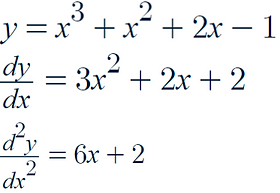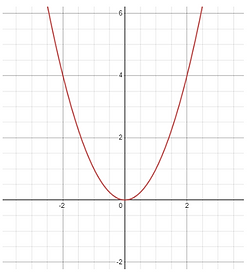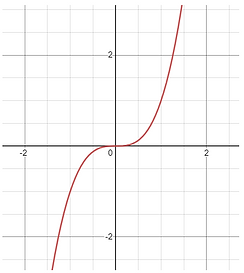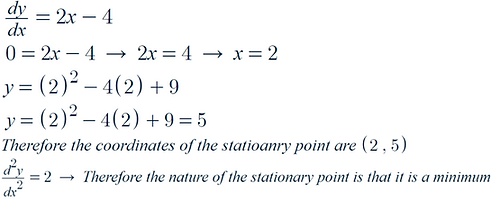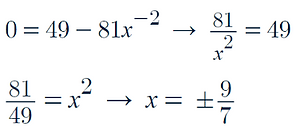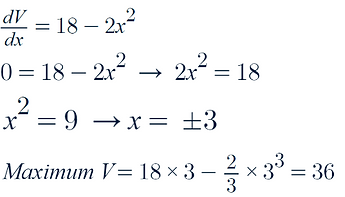Overview
-
Gradient Function
-
Tangent and Normal Line of a Curve
-
Second Derivative
-
Minimum and Maximum Points
-
Minimum and Maximum of Problems
Gradient Function
What is the gradient function:
-
The gradient function gives the gradient of a curve at a specific point on a curve
-
It is represented as:
Finding the gradient function of a curve:
-
In order to find the gradient function we need differentiate the curve equations
-
To do this we multiply the coefficient by the power and minus 1 from the power:
-
For example:
Practice Questions:
1.
2.
Solutions:
1.
2.
Tangent and Normal Line of a Curve
Finding tangent lines to curves:
-
Using the gradient function we can the gradient of the any point on a curve
-
This allows gives the gradient of the tangent at this point and we can therefore find the equation of the line
-
Let's consider the question:
-
In order to find the gradient of the tangent at (-1 , 5), we need to find the gradient function:
-
Now we need to find the gradient at the point (-1 , 5)
-
Therefore the gradient of the tangent is –7
-
Now we can find the equation of the tangent using the point (-1 , 5) and the gradient:
-
Therefore, the tangent equation is:
Finding the normal lines to curves:
-
Here we need to find the gradient at the specific point on a curve
-
Then we need to find the negative reciprocal of the gradient as the normal line is perpendicular to the curve
-
In order to find the gradient of the tangent at (3, 9), we need to find the gradient function:
-
Now we need to find the gradient at the point (3 , 9):
-
Now we need the negative reciprocal
-
Therefore the gradient of the tangent is –1/6
-
Now we can find the equation of the tangent using the point (3 , 9) and the gradient:
-
Therefore, the tangent equation is:
Second Derivative
What is the second derivative:
-
This is a function that measures the rate of change of gradient
-
It is represented as:
How to find the second derivative of a curve:
-
We need to differentiate the curve equation twice
Practice Question:
Solutions:
Minimum and Maximum Points
What is a minimum point:
What is a maximum point:
What is a point of inflection
How to find the minimum or maximum points on a graph:
-
We need to find the gradient function of the curve
-
Maximum or minimum points are stationary, which is when the gradient is 0
-
So we then let our gradient function equal 0
-
For example:
-
We start by finding the gradient function
-
We then set it equal to zero and solve
-
Therefore the x coordinate is 2
How can we prove that a stationary point is minimum or maximum or point of inflection:
-
We can do this by using the second derivative
-
If the second derivative is greater than 0 then it is a minimum point
-
If the second derivative is equal to 0 then is a point of inflection
-
If the second derivative is less that 0 then it is a maximum point
-
Consider the curve:
-
Find the stationary point of the graph
-
Now we need to find the second derivative at x = 0
-
Therefore as our second derivative equals 0, the nature of the stationary point is that it is a point of inflection
Practice Question
Solutions:
Minimum and Maximum of Problems
How to find maximum and minimums of problems:
-
This is just the same before but with no graph:
-
For example
-
We need to start by differentiating this function in terms of V and x:
-
As we are looking for minimum velocity we let the rate of change of V equal 0 and solve for x:
-
As x > 0, we know that x = +9/7
-
We therefore plug in the value of x and find the minimum value of V:
Practice Question:
Solutions:









